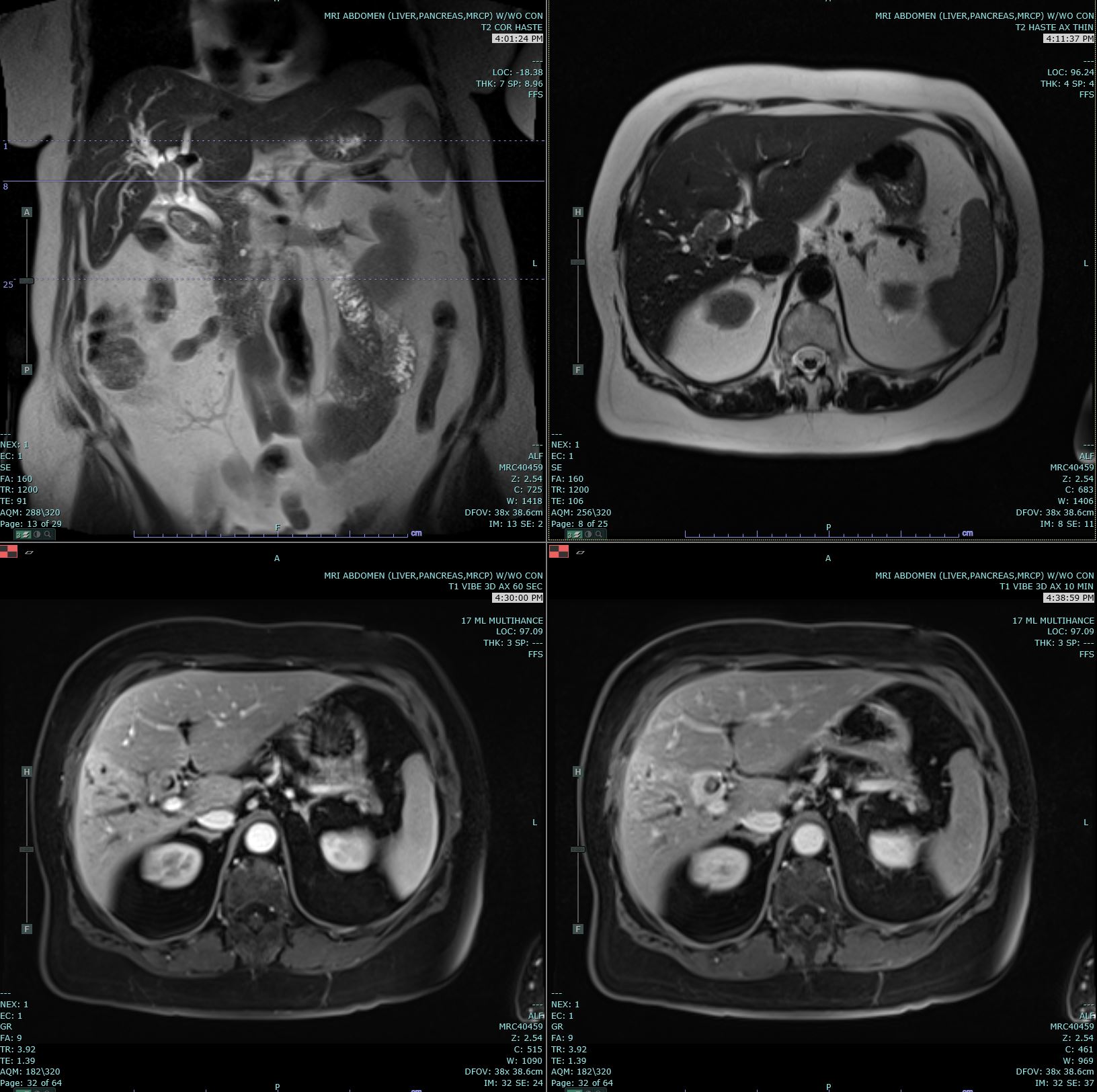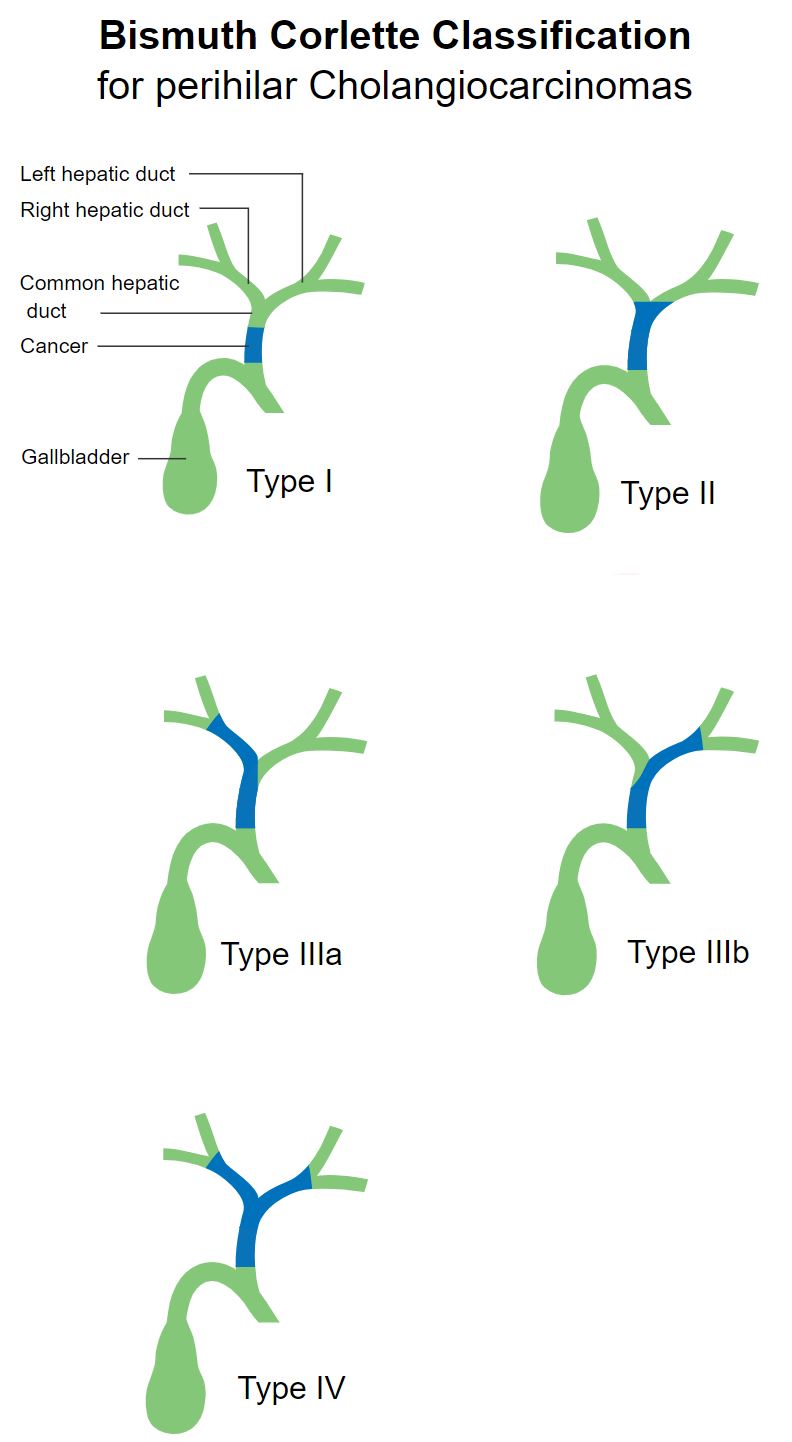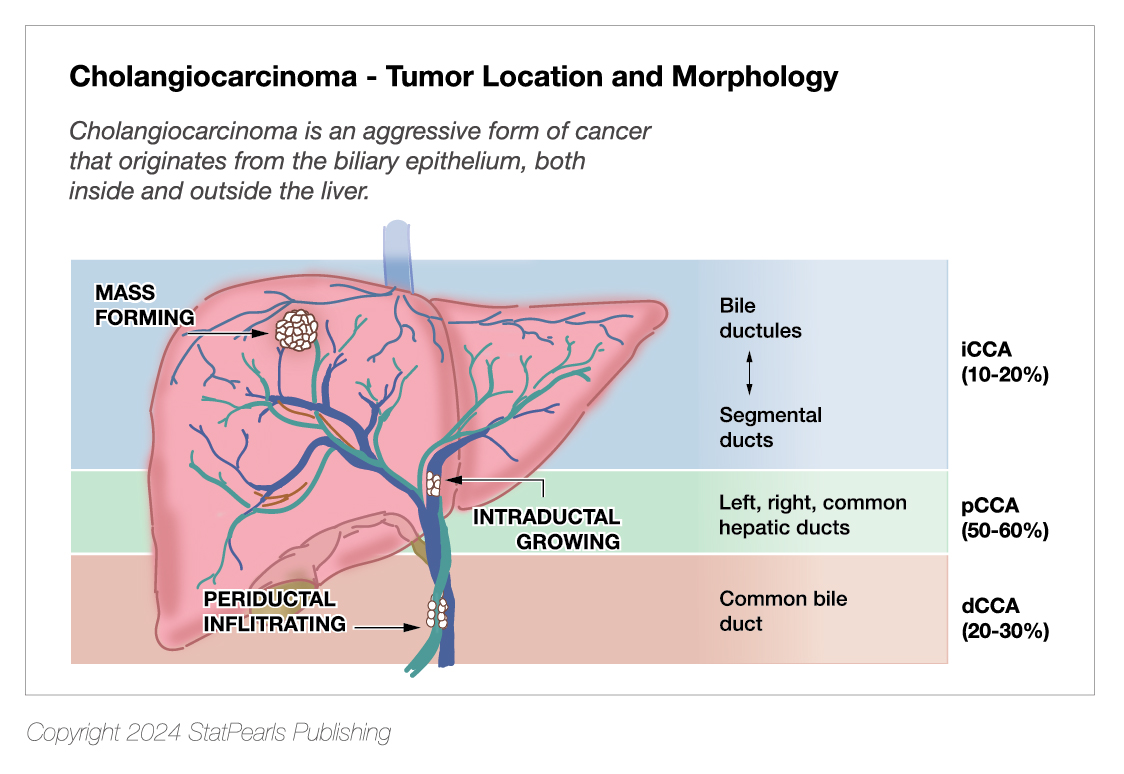[1]
Brindley PJ, Bachini M, Ilyas SI, Khan SA, Loukas A, Sirica AE, Teh BT, Wongkham S, Gores GJ. Cholangiocarcinoma. Nature reviews. Disease primers. 2021 Sep 9:7(1):65. doi: 10.1038/s41572-021-00300-2. Epub 2021 Sep 9
[PubMed PMID: 34504109]
[2]
Sarcognato S, Sacchi D, Fassan M, Fabris L, Cadamuro M, Zanus G, Cataldo I, Capelli P, Baciorri F, Cacciatore M, Guido M. Cholangiocarcinoma. Pathologica. 2021 Jun:113(3):158-169. doi: 10.32074/1591-951X-252. Epub
[PubMed PMID: 34294934]
[3]
. Cholangiocarcinoma. Nature reviews. Disease primers. 2021 Sep 9:7(1):66. doi: 10.1038/s41572-021-00305-x. Epub 2021 Sep 9
[PubMed PMID: 34504108]
[4]
Khan SA, Tavolari S, Brandi G. Cholangiocarcinoma: Epidemiology and risk factors. Liver international : official journal of the International Association for the Study of the Liver. 2019 May:39 Suppl 1():19-31. doi: 10.1111/liv.14095. Epub 2019 Mar 24
[PubMed PMID: 30851228]
[5]
Banales JM, Cardinale V, Carpino G, Marzioni M, Andersen JB, Invernizzi P, Lind GE, Folseraas T, Forbes SJ, Fouassier L, Geier A, Calvisi DF, Mertens JC, Trauner M, Benedetti A, Maroni L, Vaquero J, Macias RI, Raggi C, Perugorria MJ, Gaudio E, Boberg KM, Marin JJ, Alvaro D. Expert consensus document: Cholangiocarcinoma: current knowledge and future perspectives consensus statement from the European Network for the Study of Cholangiocarcinoma (ENS-CCA). Nature reviews. Gastroenterology & hepatology. 2016 May:13(5):261-80. doi: 10.1038/nrgastro.2016.51. Epub 2016 Apr 20
[PubMed PMID: 27095655]
Level 3 (low-level) evidence
[6]
Namsanor J, Kiatsopit N, Laha T, Andrews RH, Petney TN, Sithithaworn P. Infection Dynamics of Opisthorchis viverrini Metacercariae in Cyprinid Fishes from Two Endemic Areas in Thailand and Lao PDR. The American journal of tropical medicine and hygiene. 2020 Jan:102(1):110-116. doi: 10.4269/ajtmh.19-0432. Epub
[PubMed PMID: 31701859]
[7]
Boonstra K, Weersma RK, van Erpecum KJ, Rauws EA, Spanier BW, Poen AC, van Nieuwkerk KM, Drenth JP, Witteman BJ, Tuynman HA, Naber AH, Kingma PJ, van Buuren HR, van Hoek B, Vleggaar FP, van Geloven N, Beuers U, Ponsioen CY, EpiPSCPBC Study Group. Population-based epidemiology, malignancy risk, and outcome of primary sclerosing cholangitis. Hepatology (Baltimore, Md.). 2013 Dec:58(6):2045-55. doi: 10.1002/hep.26565. Epub 2013 Oct 17
[PubMed PMID: 23775876]
[8]
Huang D, Joo H, Song N, Cho S, Kim W, Shin A. Association between gallstones and the risk of biliary tract cancer: a systematic review and meta-analysis. Epidemiology and health. 2021:43():e2021011. doi: 10.4178/epih.e2021011. Epub 2021 Feb 3
[PubMed PMID: 33541011]
Level 1 (high-level) evidence
[10]
Simo KA, Mckillop IH, Ahrens WA, Martinie JB, Iannitti DA, Sindram D. Invasive biliary mucinous cystic neoplasm: a review. HPB : the official journal of the International Hepato Pancreato Biliary Association. 2012 Nov:14(11):725-40. doi: 10.1111/j.1477-2574.2012.00532.x. Epub 2012 Jul 22
[PubMed PMID: 23043661]
[11]
Krawczyk M, Ziarkiewicz-Wróblewska B, Podgórska J, Grzybowski J, Gierej B, Krawczyk P, Grąt M, Kornasiewicz O, Skalski M, Wróblewski T. Intraductal papillary neoplasm of the bile duct - A comprehensive review. Advances in medical sciences. 2021 Mar:66(1):138-147. doi: 10.1016/j.advms.2021.01.005. Epub 2021 Feb 6
[PubMed PMID: 33556909]
Level 3 (low-level) evidence
[12]
Tyson GL, El-Serag HB. Risk factors for cholangiocarcinoma. Hepatology (Baltimore, Md.). 2011 Jul:54(1):173-84. doi: 10.1002/hep.24351. Epub
[PubMed PMID: 21488076]
[13]
Khan AS, Dageforde LA. Cholangiocarcinoma. The Surgical clinics of North America. 2019 Apr:99(2):315-335. doi: 10.1016/j.suc.2018.12.004. Epub 2019 Feb 10
[PubMed PMID: 30846037]
[14]
Massarweh NN, El-Serag HB. Epidemiology of Hepatocellular Carcinoma and Intrahepatic Cholangiocarcinoma. Cancer control : journal of the Moffitt Cancer Center. 2017 Jul-Sep:24(3):1073274817729245. doi: 10.1177/1073274817729245. Epub
[PubMed PMID: 28975830]
[15]
Rahib L, Smith BD, Aizenberg R, Rosenzweig AB, Fleshman JM, Matrisian LM. Projecting cancer incidence and deaths to 2030: the unexpected burden of thyroid, liver, and pancreas cancers in the United States. Cancer research. 2014 Jun 1:74(11):2913-21. doi: 10.1158/0008-5472.CAN-14-0155. Epub
[PubMed PMID: 24840647]
[16]
Hezel AF, Deshpande V, Zhu AX. Genetics of biliary tract cancers and emerging targeted therapies. Journal of clinical oncology : official journal of the American Society of Clinical Oncology. 2010 Jul 20:28(21):3531-40. doi: 10.1200/JCO.2009.27.4787. Epub 2010 Jun 14
[PubMed PMID: 20547994]
[17]
Uson Junior PLS, Borad MJ. Precision approaches for cholangiocarcinoma: progress in clinical trials and beyond. Expert opinion on investigational drugs. 2022 Jan:31(1):125-131. doi: 10.1080/13543784.2022.2017882. Epub 2022 Jan 7
[PubMed PMID: 34904492]
Level 3 (low-level) evidence
[18]
Yamada T, Nakanishi Y, Hayashi H, Tanishima S, Mori R, Fujii K, Okamura K, Tsuchikawa T, Nakamura T, Noji T, Asano T, Matsui A, Tanaka K, Watanabe Y, Kurashima Y, Ebihara Y, Murakami S, Shichinohe T, Mitsuhashi T, Hirano S. Targeted amplicon sequencing for primary tumors and matched lymph node metastases in patients with extrahepatic cholangiocarcinoma. HPB : the official journal of the International Hepato Pancreato Biliary Association. 2022 Jul:24(7):1035-1043. doi: 10.1016/j.hpb.2021.11.008. Epub 2021 Nov 25
[PubMed PMID: 34903468]
[19]
Ahmad S, Badr B, Khan A, Rehman R, Ghias K, Muhammad JS, Khan MR. The Role of K-Ras and P53 in Biliary Tract Carcinoma. JPMA. The Journal of the Pakistan Medical Association. 2021 Oct:71(10):2378-2384. doi: 10.47391/JPMA.11-1322. Epub
[PubMed PMID: 34974575]
[20]
Lim JH. Cholangiocarcinoma: morphologic classification according to growth pattern and imaging findings. AJR. American journal of roentgenology. 2003 Sep:181(3):819-27
[PubMed PMID: 12933488]
[21]
Chen Y, Liu X, Huang L, Chen L, Wang B. Clinicopathological, etiological and molecular characteristics of intrahepatic cholangiocarcinoma subtypes classified by mucin production and immunohistochemical features. Expert review of molecular diagnostics. 2023 May:23(5):445-456. doi: 10.1080/14737159.2023.2205588. Epub 2023 Apr 23
[PubMed PMID: 37078255]
[22]
Chung T, Park YN. Up-to-Date Pathologic Classification and Molecular Characteristics of Intrahepatic Cholangiocarcinoma. Frontiers in medicine. 2022:9():857140. doi: 10.3389/fmed.2022.857140. Epub 2022 Mar 31
[PubMed PMID: 35433771]
[23]
Banales JM, Marin JJG, Lamarca A, Rodrigues PM, Khan SA, Roberts LR, Cardinale V, Carpino G, Andersen JB, Braconi C, Calvisi DF, Perugorria MJ, Fabris L, Boulter L, Macias RIR, Gaudio E, Alvaro D, Gradilone SA, Strazzabosco M, Marzioni M, Coulouarn C, Fouassier L, Raggi C, Invernizzi P, Mertens JC, Moncsek A, Rizvi S, Heimbach J, Koerkamp BG, Bruix J, Forner A, Bridgewater J, Valle JW, Gores GJ. Cholangiocarcinoma 2020: the next horizon in mechanisms and management. Nature reviews. Gastroenterology & hepatology. 2020 Sep:17(9):557-588. doi: 10.1038/s41575-020-0310-z. Epub 2020 Jun 30
[PubMed PMID: 32606456]
[24]
Guedj N. Pathology of Cholangiocarcinomas. Current oncology (Toronto, Ont.). 2022 Dec 26:30(1):370-380. doi: 10.3390/curroncol30010030. Epub 2022 Dec 26
[PubMed PMID: 36661679]
[25]
Blechacz B, Komuta M, Roskams T, Gores GJ. Clinical diagnosis and staging of cholangiocarcinoma. Nature reviews. Gastroenterology & hepatology. 2011 Aug 2:8(9):512-22. doi: 10.1038/nrgastro.2011.131. Epub 2011 Aug 2
[PubMed PMID: 21808282]
[26]
Carson SW, Craven KE, Nauen D, Montemayor K, Yarchoan M, Burns WR, Merlo CA, West NE. Rapidly progressive metastatic cholangiocarcinoma in a postpartum patient with cystic fibrosis: a case report. BMC pulmonary medicine. 2020 Nov 16:20(1):298. doi: 10.1186/s12890-020-01337-x. Epub 2020 Nov 16
[PubMed PMID: 33198722]
Level 3 (low-level) evidence
[27]
Pelsang RE, Johlin FC. A percutaneous biopsy technique for patients with suspected biliary or pancreatic cancer without a radiographic mass. Abdominal imaging. 1997 May-Jun:22(3):307-10
[PubMed PMID: 9107656]
[28]
Engelbrecht MR, Katz SS, van Gulik TM, Laméris JS, van Delden OM. Imaging of perihilar cholangiocarcinoma. AJR. American journal of roentgenology. 2015 Apr:204(4):782-91. doi: 10.2214/AJR.14.12830. Epub
[PubMed PMID: 25794067]
[29]
Shin DW, Moon SH, Kim JH. Diagnosis of Cholangiocarcinoma. Diagnostics (Basel, Switzerland). 2023 Jan 8:13(2):. doi: 10.3390/diagnostics13020233. Epub 2023 Jan 8
[PubMed PMID: 36673043]
[30]
Ellis RJ, Soares KC, Jarnagin WR. Preoperative Management of Perihilar Cholangiocarcinoma. Cancers. 2022 Apr 24:14(9):. doi: 10.3390/cancers14092119. Epub 2022 Apr 24
[PubMed PMID: 35565250]
[31]
Orzan RI, Pojoga C, Agoston R, Seicean R, Seicean A. Endoscopic Ultrasound in the Diagnosis of Extrahepatic Cholangiocarcinoma: What Do We Know in 2023? Diagnostics (Basel, Switzerland). 2023 Mar 8:13(6):. doi: 10.3390/diagnostics13061023. Epub 2023 Mar 8
[PubMed PMID: 36980331]
[32]
Mocan T, Horhat A, Mois E, Graur F, Tefas C, Craciun R, Nenu I, Spârchez M, Sparchez Z. Endoscopic or percutaneous biliary drainage in hilar cholangiocarcinoma: When and how? World journal of gastrointestinal oncology. 2021 Dec 15:13(12):2050-2063. doi: 10.4251/wjgo.v13.i12.2050. Epub
[PubMed PMID: 35070041]
[33]
van der Gaag NA, Rauws EA, van Eijck CH, Bruno MJ, van der Harst E, Kubben FJ, Gerritsen JJ, Greve JW, Gerhards MF, de Hingh IH, Klinkenbijl JH, Nio CY, de Castro SM, Busch OR, van Gulik TM, Bossuyt PM, Gouma DJ. Preoperative biliary drainage for cancer of the head of the pancreas. The New England journal of medicine. 2010 Jan 14:362(2):129-37. doi: 10.1056/NEJMoa0903230. Epub
[PubMed PMID: 20071702]
[34]
Tran Cao HS, Vauthey JN. Portal Vein Embolization for Perihilar Cholangiocarcinoma: A Story Worth Repeating. Annals of surgical oncology. 2020 Jul:27(7):2120-2121. doi: 10.1245/s10434-020-08280-5. Epub 2020 Feb 28
[PubMed PMID: 32112210]
[35]
Narula N, Aloia TA. Portal vein embolization in extended liver resection. Langenbeck's archives of surgery. 2017 Aug:402(5):727-735. doi: 10.1007/s00423-017-1591-8. Epub 2017 May 31
[PubMed PMID: 28567528]
[36]
Owen M, Makary MS, Beal EW. Locoregional Therapy for Intrahepatic Cholangiocarcinoma. Cancers. 2023 Apr 20:15(8):. doi: 10.3390/cancers15082384. Epub 2023 Apr 20
[PubMed PMID: 37190311]
[37]
Mosconi C, Solaini L, Vara G, Brandi N, Cappelli A, Modestino F, Cucchetti A, Golfieri R. Transarterial Chemoembolization and Radioembolization for Unresectable Intrahepatic Cholangiocarcinoma-a Systemic Review and Meta-Analysis. Cardiovascular and interventional radiology. 2021 May:44(5):728-738. doi: 10.1007/s00270-021-02800-w. Epub 2021 Mar 11
[PubMed PMID: 33709272]
Level 1 (high-level) evidence
[38]
Sweeney J, Parikh N, El-Haddad G, Kis B. Ablation of Intrahepatic Cholangiocarcinoma. Seminars in interventional radiology. 2019 Oct:36(4):298-302. doi: 10.1055/s-0039-1696649. Epub 2019 Oct 31
[PubMed PMID: 31680720]
[39]
Charalampopoulos G, Iezzi R, Tsitskari M, Mazioti A, Papakonstantinou O, Kelekis A, Kelekis N, Filippiadis D. Role of Percutaneous Ablation in the Management of Intrahepatic Cholangiocarcinoma. Medicina (Kaunas, Lithuania). 2023 Jun 22:59(7):. doi: 10.3390/medicina59071186. Epub 2023 Jun 22
[PubMed PMID: 37511998]
[40]
Rossi AJ, Khan TM, Luna AJ, Cercek A, Jarnagin WR, Hernandez JM. Hepatic Artery Infusion Pump (HAIP) Therapy Versus Chemotherapy in the First-Line Setting for Patients with Unresectable Intrahepatic Cholangiocarcinoma. Annals of surgical oncology. 2022 Jan:29(1):35-36. doi: 10.1245/s10434-021-10279-5. Epub 2021 Jun 11
[PubMed PMID: 34117578]
[41]
Thiels CA, D'Angelica MI. Hepatic artery infusion pumps. Journal of surgical oncology. 2020 Jul:122(1):70-77. doi: 10.1002/jso.25913. Epub 2020 Mar 25
[PubMed PMID: 32215927]
[42]
Elvevi A, Laffusa A, Scaravaglio M, Rossi RE, Longarini R, Stagno AM, Cristoferi L, Ciaccio A, Cortinovis DL, Invernizzi P, Massironi S. Clinical treatment of cholangiocarcinoma: an updated comprehensive review. Annals of hepatology. 2022 Sep-Oct:27(5):100737. doi: 10.1016/j.aohep.2022.100737. Epub 2022 Jul 7
[PubMed PMID: 35809836]
[43]
Ben Khaled N, Jacob S, Rössler D, Bösch F, De Toni EN, Werner J, Ricke J, Mayerle J, Seidensticker M, Schulz C, Fabritius MP. Current State of Multidisciplinary Treatment in Cholangiocarcinoma. Digestive diseases (Basel, Switzerland). 2022:40(5):581-595. doi: 10.1159/000520346. Epub 2021 Oct 25
[PubMed PMID: 34695826]
[44]
Jena SS, Mehta NN, Nundy S. Surgical management of hilar cholangiocarcinoma: Controversies and recommendations. Annals of hepato-biliary-pancreatic surgery. 2023 Aug 31:27(3):227-240. doi: 10.14701/ahbps.23-028. Epub 2023 Jul 6
[PubMed PMID: 37408334]
[45]
Soares KC, Jarnagin WR. The Landmark Series: Hilar Cholangiocarcinoma. Annals of surgical oncology. 2021 Aug:28(8):4158-4170. doi: 10.1245/s10434-021-09871-6. Epub 2021 Apr 7
[PubMed PMID: 33829358]
[46]
Xin Y, Liu Q, Zhang J, Lu J, Song X, Zhan H, Chen X, Cao Z, Li Y, Huang Z. Hilar cholangiocarcinoma: Value of high-resolution enhanced magnetic resonance imaging for preoperative evaluation. Journal of cancer research and therapeutics. 2020:16(7):1634-1640. doi: 10.4103/jcrt.JCRT_140_20. Epub
[PubMed PMID: 33565510]
[47]
Bârcu A, Kraft A, Verdea C, Croitoru A, Lupescu I, Tomescu D, Popescu I, Botea F. En-Bloc Complete Segment 1 Resection and Left Hepatectomy for Klatskin Tumor. Chirurgia (Bucharest, Romania : 1990). 2021 Oct:116(5):634-638. doi: 10.21614/chirurgia.116.5.634. Epub
[PubMed PMID: 34749860]
[48]
Cillo U, Fondevila C, Donadon M, Gringeri E, Mocchegiani F, Schlitt HJ, Ijzermans JNM, Vivarelli M, Zieniewicz K, Olde Damink SWM, Groot Koerkamp B. Surgery for cholangiocarcinoma. Liver international : official journal of the International Association for the Study of the Liver. 2019 May:39 Suppl 1(Suppl Suppl 1):143-155. doi: 10.1111/liv.14089. Epub
[PubMed PMID: 30843343]
[49]
Ben-Josef E, Guthrie KA, El-Khoueiry AB, Corless CL, Zalupski MM, Lowy AM, Thomas CR Jr, Alberts SR, Dawson LA, Micetich KC, Thomas MB, Siegel AB, Blanke CD. SWOG S0809: A Phase II Intergroup Trial of Adjuvant Capecitabine and Gemcitabine Followed by Radiotherapy and Concurrent Capecitabine in Extrahepatic Cholangiocarcinoma and Gallbladder Carcinoma. Journal of clinical oncology : official journal of the American Society of Clinical Oncology. 2015 Aug 20:33(24):2617-22. doi: 10.1200/JCO.2014.60.2219. Epub 2015 May 11
[PubMed PMID: 25964250]
[50]
Gorji L, Beal EW. Surgical Treatment of Distal Cholangiocarcinoma. Current oncology (Toronto, Ont.). 2022 Sep 17:29(9):6674-6687. doi: 10.3390/curroncol29090524. Epub 2022 Sep 17
[PubMed PMID: 36135093]
[51]
Zaborowski A, Heneghan HM, Fiore B, Stafford A, Gallagher T, Geoghegan J, Maguire D, Hoti E. Neoadjuvant Chemoradiotherapy and Liver Transplantation for Unresectable Hilar Cholangiocarcinoma: The Irish Experience of the Mayo Protocol. Transplantation. 2020 Oct:104(10):2097-2104. doi: 10.1097/TP.0000000000003114. Epub
[PubMed PMID: 31972704]
[52]
Apisarnthanarax S, Barry A, Cao M, Czito B, DeMatteo R, Drinane M, Hallemeier CL, Koay EJ, Lasley F, Meyer J, Owen D, Pursley J, Schaub SK, Smith G, Venepalli NK, Zibari G, Cardenes H. External Beam Radiation Therapy for Primary Liver Cancers: An ASTRO Clinical Practice Guideline. Practical radiation oncology. 2022 Jan-Feb:12(1):28-51. doi: 10.1016/j.prro.2021.09.004. Epub 2021 Oct 21
[PubMed PMID: 34688956]
Level 1 (high-level) evidence
[53]
Rizvi S, Khan SA, Hallemeier CL, Kelley RK, Gores GJ. Cholangiocarcinoma - evolving concepts and therapeutic strategies. Nature reviews. Clinical oncology. 2018 Feb:15(2):95-111. doi: 10.1038/nrclinonc.2017.157. Epub 2017 Oct 10
[PubMed PMID: 28994423]
[54]
Primrose JN, Fox RP, Palmer DH, Malik HZ, Prasad R, Mirza D, Anthony A, Corrie P, Falk S, Finch-Jones M, Wasan H, Ross P, Wall L, Wadsley J, Evans JTR, Stocken D, Praseedom R, Ma YT, Davidson B, Neoptolemos JP, Iveson T, Raftery J, Zhu S, Cunningham D, Garden OJ, Stubbs C, Valle JW, Bridgewater J, BILCAP study group. Capecitabine compared with observation in resected biliary tract cancer (BILCAP): a randomised, controlled, multicentre, phase 3 study. The Lancet. Oncology. 2019 May:20(5):663-673. doi: 10.1016/S1470-2045(18)30915-X. Epub 2019 Mar 25
[PubMed PMID: 30922733]
Level 1 (high-level) evidence
[55]
Rizzo A, Brandi G. BILCAP trial and adjuvant capecitabine in resectable biliary tract cancer: reflections on a standard of care. Expert review of gastroenterology & hepatology. 2021 May:15(5):483-485. doi: 10.1080/17474124.2021.1864325. Epub 2020 Dec 18
[PubMed PMID: 33307876]
[56]
Lamarca A, Edeline J, McNamara MG, Hubner RA, Nagino M, Bridgewater J, Primrose J, Valle JW. Current standards and future perspectives in adjuvant treatment for biliary tract cancers. Cancer treatment reviews. 2020 Mar:84():101936. doi: 10.1016/j.ctrv.2019.101936. Epub 2019 Dec 4
[PubMed PMID: 31986437]
Level 3 (low-level) evidence
[57]
Rizzo A, Brandi G. Neoadjuvant therapy for cholangiocarcinoma: A comprehensive literature review. Cancer treatment and research communications. 2021:27():100354. doi: 10.1016/j.ctarc.2021.100354. Epub 2021 Mar 16
[PubMed PMID: 33756174]
[58]
Ebia MI, Sankar K, Osipov A, Hendifar AE, Gong J. TOPAZ-1: a new standard of care for advanced biliary tract cancers? Immunotherapy. 2023 May:15(7):473-476. doi: 10.2217/imt-2022-0269. Epub 2023 Mar 23
[PubMed PMID: 36950948]
[59]
Almhanna K. Immune checkpoint inhibitors in combination with chemotherapy for patients with biliary tract cancer: what did we learn from TOPAZ-1 and KEYNOTE-966. Translational cancer research. 2024 Jan 31:13(1):22-24. doi: 10.21037/tcr-23-1763. Epub 2024 Jan 17
[PubMed PMID: 38410206]
[60]
Kelley RK, Bridgewater J, Gores GJ, Zhu AX. Systemic therapies for intrahepatic cholangiocarcinoma. Journal of hepatology. 2020 Feb:72(2):353-363. doi: 10.1016/j.jhep.2019.10.009. Epub
[PubMed PMID: 31954497]



